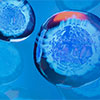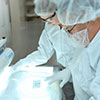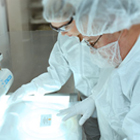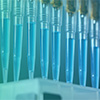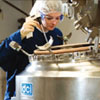Single-use+Pressure+Sensor
Numéro de catalogue:
(BOSSBS-12552R-CY7)
Fournisseur:
Bioss
Description:
Mahogany (MG), originally identified as a protein involved in pigmentation, acts in conjunction with melanocortin receptors to suppress diet-induced obesity. Mahogany contains a single transmembrane domain, and it is expressed in a broad range of tissues, including the hypothalamus and pigment cells. Mutations within the mahogany gene were shown to rescue agouti-lethal-yellow mutant mice from obesity. The extracellular domain of mouse mahogany is the ortholog of the human protein attractin. Attractin (also designated DPPT-L) is a human serum glycoprotein and is a member of the CUB family of cell adhesion and guidance proteins. Attractin is expressed on activated T cells and is released from the cells 48 to 72 hours after activation.
UOM:
1 * 100 µl
Numéro de catalogue:
(BOSSBS-3220R-CY7)
Fournisseur:
Bioss
Description:
This gene is a member of the Tyr protein kinase family and the epidermal growth factor receptor subfamily. It encodes a single-pass type I membrane protein with multiple cysteine rich domains, a transmembrane domain, a tyrosine kinase domain, a phosphotidylinositol-3 kinase binding site and a PDZ domain binding motif. The protein binds to and is activated by neuregulins and other factors and induces a variety of cellular responses including mitogenesis and differentiation. Multiple proteolytic events allow for the release of a cytoplasmic fragment and an extracellular fragment. Mutations in this gene have been associated with cancer. Alternatively spliced variants which encode different protein isoforms have been described; however, not all variants have been fully characterized. [provided by RefSeq, Jul 2008].
UOM:
1 * 100 µl
Numéro de catalogue:
(BOSSBS-12872R-CY3)
Fournisseur:
Bioss
Description:
Bloom’s syndrome is an autosomal recessive disorder characterized by pre- and post-natal growth deficiencies, sun sensitivity, immunodeficiency and a predisposition to various cancers. The gene responsible for Bloom’s syndrome, BLM, encodes a protein homologous to the RecQ helicase of E. coli and is mutated in most Bloom’s syndrome patients. One characteristic of Bloom’s syndrome is an increased frequency of sister chromatid exchange (SCE). BLM has been shown to unwind G4 DNA, and a failure of this function is thought to be responsible for the increased rate of SCE. BLM is known to be translocated to the nucleus, where its ATPase activity is stimulated by both single- and double-stranded DNA. Mutations in the yeast SGS1, a homolog of BLM, are known to cause mitotic hyperrecombination similiar to that observed in Bloom’s cells.
UOM:
1 * 100 µl
Numéro de catalogue:
(BOSSBS-12872R-CY7)
Fournisseur:
Bioss
Description:
Bloom’s syndrome is an autosomal recessive disorder characterized by pre- and post-natal growth deficiencies, sun sensitivity, immunodeficiency and a predisposition to various cancers. The gene responsible for Bloom’s syndrome, BLM, encodes a protein homologous to the RecQ helicase of E. coli and is mutated in most Bloom’s syndrome patients. One characteristic of Bloom’s syndrome is an increased frequency of sister chromatid exchange (SCE). BLM has been shown to unwind G4 DNA, and a failure of this function is thought to be responsible for the increased rate of SCE. BLM is known to be translocated to the nucleus, where its ATPase activity is stimulated by both single- and double-stranded DNA. Mutations in the yeast SGS1, a homolog of BLM, are known to cause mitotic hyperrecombination similiar to that observed in Bloom’s cells.
UOM:
1 * 100 µl
Numéro de catalogue:
(BOSSBS-7952R-CY5.5)
Fournisseur:
Bioss
Description:
ADCK2 (aarF domain containing kinase 2), also known as AARF, is a 626 amino acid single-pass membrane protein belonging to the protein kinase superfamily and the ADCK protein kinase family. The ADCK family consists of five paralogs in human (ADCK1-5). Encoded by a gene that maps to human chromosome 7q34, ADCK2 contains one protein kinase domain. ADCK2 participates in ATP and nucleotide binding, transferase functions and protein serine/threonine kinase activities. Expression of ADCK2 inversely correlates with cellular viability, suggesting elevated expression of ADCK2 may be essential for tumour survival. ADCK2 is necessary for cell proliferation of glioblastoma multiforme (GBM), a fatal primary brain tumor containing countless genetic and epigenetic alterations.
UOM:
1 * 100 µl
Numéro de catalogue:
(BOSSBS-7952R-CY3)
Fournisseur:
Bioss
Description:
ADCK2 (aarF domain containing kinase 2), also known as AARF, is a 626 amino acid single-pass membrane protein belonging to the protein kinase superfamily and the ADCK protein kinase family. The ADCK family consists of five paralogs in human (ADCK1-5). Encoded by a gene that maps to human chromosome 7q34, ADCK2 contains one protein kinase domain. ADCK2 participates in ATP and nucleotide binding, transferase functions and protein serine/threonine kinase activities. Expression of ADCK2 inversely correlates with cellular viability, suggesting elevated expression of ADCK2 may be essential for tumour survival. ADCK2 is necessary for cell proliferation of glioblastoma multiforme (GBM), a fatal primary brain tumor containing countless genetic and epigenetic alterations.
UOM:
1 * 100 µl
Numéro de catalogue:
(BOSSBS-10470R)
Fournisseur:
Bioss
Description:
This gene is a member of the Tyr protein kinase family and the epidermal growth factor receptor subfamily. It encodes a single-pass type I membrane protein with multiple cysteine rich domains, a transmembrane domain, a tyrosine kinase domain, a phosphotidylinositol-3 kinase binding site and a PDZ domain binding motif. The protein binds to and is activated by neuregulins and other factors and induces a variety of cellular responses including mitogenesis and differentiation. Multiple proteolytic events allow for the release of a cytoplasmic fragment and an extracellular fragment. Mutations in this gene have been associated with cancer. Alternatively spliced variants which encode different protein isoforms have been described; however, not all variants have been fully characterized. [provided by RefSeq, Jul 2008].
UOM:
1 * 100 µl
Numéro de catalogue:
(BOSSBS-10722R-CY5)
Fournisseur:
Bioss
Description:
Staphylococcal enterotoxins represent a group of proteins, which are secreted by Staphylococcus aureus and cause staphylococcal food poisoning syndrome. The illness is characterised by high fever, hypotension, diarrhea, shock, and in some cases death. Their molecular masses range between 27 and 30 kDa. At present, seven enterotoxins are known, namely A, B, C1, C2, C3, D and E. Their amino acid sequences have been determined and it was shown that all are single chain polypeptides containing one disulfide bond formed by two half cystines located in the middle of the polypeptide chain, which form the so called cysteine loop. SEB is an extremely potent activator of T cells, stimulating the production and secretion of various cytokines which mediate many of the toxic effects of SEB.
UOM:
1 * 100 µl
Numéro de catalogue:
(BOSSBS-5343R-CY5.5)
Fournisseur:
Bioss
Description:
This gene is a member of the Tyr protein kinase family and the epidermal growth factor receptor subfamily. It encodes a single-pass type I membrane protein with multiple cysteine rich domains, a transmembrane domain, a tyrosine kinase domain, a phosphotidylinositol-3 kinase binding site and a PDZ domain binding motif. The protein binds to and is activated by neuregulins and other factors and induces a variety of cellular responses including mitogenesis and differentiation. Multiple proteolytic events allow for the release of a cytoplasmic fragment and an extracellular fragment. Mutations in this gene have been associated with cancer. Alternatively spliced variants which encode different protein isoforms have been described; however, not all variants have been fully characterized. [provided by RefSeq, Jul 2008].
UOM:
1 * 100 µl
Numéro de catalogue:
(BOSSBS-5343R-CY5)
Fournisseur:
Bioss
Description:
This gene is a member of the Tyr protein kinase family and the epidermal growth factor receptor subfamily. It encodes a single-pass type I membrane protein with multiple cysteine rich domains, a transmembrane domain, a tyrosine kinase domain, a phosphotidylinositol-3 kinase binding site and a PDZ domain binding motif. The protein binds to and is activated by neuregulins and other factors and induces a variety of cellular responses including mitogenesis and differentiation. Multiple proteolytic events allow for the release of a cytoplasmic fragment and an extracellular fragment. Mutations in this gene have been associated with cancer. Alternatively spliced variants which encode different protein isoforms have been described; however, not all variants have been fully characterized. [provided by RefSeq, Jul 2008].
UOM:
1 * 100 µl
Numéro de catalogue:
(BOSSBS-13723R-CY3)
Fournisseur:
Bioss
Description:
Protocadherins are a large family of cadherin-like cell adhesion proteins that are involved in the establishment and maintenance of neuronal connections in the brain. There are three protocadherin gene clusters, designated alpha, beta and gamma, all of which contain multiple tandemly arranged genes. PCDH10 (protocadherin 10), also known as PCDH19 or OL-PCDH, is a 1,040 amino acid single-pass type I membrane protein that contains six cadherin domains and one transmembrane domain. Expressed at moderate levels in brain, ovary and testis and present at lower levels in all other tissues, PCDH10 functions as a calcium-dependent cell-adhesion protein that may function as a tumor suppressor. When underexpressed, PCDH10 is associated with the progression of various carcinomas, including gastric cancer.
UOM:
1 * 100 µl
Numéro de catalogue:
(BOSSBS-13093R-CY5)
Fournisseur:
Bioss
Description:
This gene is a member of the Tyr protein kinase family and the epidermal growth factor receptor subfamily. It encodes a single-pass type I membrane protein with multiple cysteine rich domains, a transmembrane domain, a tyrosine kinase domain, a phosphotidylinositol-3 kinase binding site and a PDZ domain binding motif. The protein binds to and is activated by neuregulins and other factors and induces a variety of cellular responses including mitogenesis and differentiation. Multiple proteolytic events allow for the release of a cytoplasmic fragment and an extracellular fragment. Mutations in this gene have been associated with cancer. Alternatively spliced variants which encode different protein isoforms have been described; however, not all variants have been fully characterized. [provided by RefSeq, Jul 2008].
UOM:
1 * 100 µl
Numéro de catalogue:
(BOSSBS-11395R-CY3)
Fournisseur:
Bioss
Description:
Syntaxins were originally thought to be docking proteins, but have more recently been categorized as anchoring proteins that anchor themselves to the cytoplasmic surfaces of cellular membranes. Syntaxins bind to various proteins involved in exocytosis, including VAMPs (vesicle-associated membrane proteins), NSF (N-ethylmaleimide-sensitive factor), SNAPs (soluble NSF attachment proteins) and Synaptotagmin. Endobrevin, also designated VAMP-8 or ED, is a 100 amino acid single-pass type IV membrane protein that belongs to the synaptobrevin family. Similar in sequence to the synaptobrevins, endobrevin is abundantly expressed in kidney, moderately expressed in heart and spleen, and slightly expressed in brain, thymus and liver. Endobrevin interacts specifically with the SNAPs, most likely through an endobrevin-containing SNARE complex.
UOM:
1 * 100 µl
Numéro de catalogue:
(BOSSBS-11323R-CY3)
Fournisseur:
Bioss
Description:
Neuroglycan C is a brain-specific chondroitin sulfate proteoglycan (CSPG) implicated in the proliferation of neural stem and progenitor cells. Neuro-glycan C is a single-pass membrane protein that can manifest as a part-time proteoglycan depending on the tissue expressing it. In its proteoglycan form, Neuroglycan C exhibits chondroitin sulfate glycans and functions as a receptor for midkine, a growth factor that binds heparin, to affect cytoskeletal changes. By means of ectodomain shedding, the ectodomain of Neuroglycan C is able to enhance neurite outgrowth from neurons. Neurite growth stimulation is affected by both an EGF-like and an acidic amino acid domain found on the shed ectodomain. Both domains instigate neurite growth, however, these domains exhibit differing functionality as to number of neurites produced and neuron types stimulated.
UOM:
1 * 100 µl
Numéro de catalogue:
(BOSSBS-9652R-CY5)
Fournisseur:
Bioss
Description:
C18orf1 is a 306 amino acid single-pass membrane protein that contains one LDL-receptor class A domain and belongs to the PMEPA1 family. C18orf1 exists as five alternatively spliced isoforms that display selective expression and are encoded by a gene that maps to human chromosome 18, which houses over 300 protein-coding genes and contains nearly 76 million bases. There are a variety of diseases associated with defects in chromosome 18-localized genes, some of which include Trisomy 18 (also known as Edwards syndrome), Niemann-Pick disease, hereditary hemorrhagic telangiectasia, erythropoietic protoporphyria and follicular lymphomas.
UOM:
1 * 100 µl
Numéro de catalogue:
(BOSSBS-11581R-A488)
Fournisseur:
Bioss
Description:
PDZ-GEF1 is a 1,499 amino acid cell membrane protein that functions as a guanine nucleotide exchange factor for Rap 1A, Rap 1B and Rap 2B GTPases. Expressed at highest levels in brain, PDZ-GEF1 is found at low levels in placenta, heart, lung and kidney, and undergoes post-translational phosphorylation following DNA damage. PDZ-GEF1 interacts with MAGI-2 and contains one Ras-GEF domain, a Ras-associating domain, one PDZ (DHR) domain, a single N-terminal Ras-GEF domain and a cyclic nucleotide-binding domain. The gene encoding PDZ-GEF1 maps to human chromosome 4q32.1.
UOM:
1 * 100 µl
Appel de prix
Le stock de cet article est limité mais peut être disponible dans un entrepôt proche de vous. Merci de vous assurer que vous êtes connecté sur le site afin que le stock disponible soit affiché. Si l'
Le stock de cet article est limité mais peut être disponible dans un entrepôt proche de vous. Merci de vous assurer que vous êtes connecté sur le site afin que le stock disponible soit affiché. Si l'
Ces articles ne peuvent être ajoutés au Panier. Veuillez contacter votre service client ou envoyer un e-mail à vwr.be@vwr.com
Une documentation supplémentaire peut être nécessaire pour l'achat de cet article. Un représentant de VWR vous contactera si nécessaire.
Ce produit a été bloqué par votre organisation. Contacter votre service d'achat pour plus d'informations.
Le produit original n'est plus disponible. Le remplacement représenté est disponible
Les produits marqués de ce symbole ne seront bientôt plus disponibles - vente jusqu'à épuisement de stock. Des alternatives peuvent être disponibles en recherchant le code article VWR indiqué ci-dessus. Si vous avez besoin d'une assistance supplémentaire, veuillez contacter notre Service Clientèle au 016 385 011.
|
|||||||||




